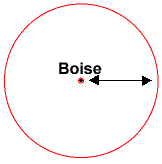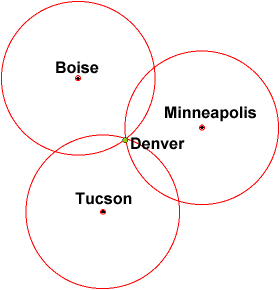Many of us use GPS almost every day — getting directions with mapping apps on our phones, tracking our food deliveries, logging our running routes — but have you ever stopped to wonder? How does GPS work??
Almost all smartphones use GPS technology; So let’s understand what this really means and why having a GPS receiver and the ability to see the sky clearly means you’ll never get lost again.
What is GPS?
When people talk about “GPS” they usually mean a GPS receiver, but the Global Positioning System (GPS) is actually a constellation of many satellites orbiting the Earth (gps.gov/systems/gps/space/”>31 in operational orbit and four were classified as “reserve” or “unhealthy.”
The US military initially developed and implemented this satellite network as a military navigation system, later making it publicly available.
Each of these 3,000 to 4,000-pound (1,361 to 1,814 kg) solar-powered satellites orbits the earth at an altitude of approximately 20,000 km (12,427 mi), making two complete rotations each day. The orbits are arranged so that at least four satellites are “visible” in the sky at any given time anywhere in the world.
A GPS receiver uses these satellites to calculate the precise location of the person using the device.
How Does GPS Work?
GPS receivers work by locating four or more of these satellites, calculating the distance to each, and using this information to infer their own location.
This process is based on a simple mathematical principle called trilateration. Trilateration in three-dimensional space can be a bit misleading, so we’ll start by explaining simple two-dimensional trilateration.
2D Trilateration
Imagine you are somewhere in the United States and completely lost; Whatever the reason, you have absolutely no idea where you are. You find a friendly local and ask “Where am I?” you ask. “You’re 625 miles from Boise, Idaho,” he says.
This is a nice and definitive fact, but it is not very useful on its own. You can be anywhere in a 625-mile radius circle around Boise, like this:


You ask someone else where you are and they say: “You are 690 miles from Minneapolis, Minnesota.” You’re getting somewhere now.
Combine this information with the Boise information and you have two intersecting circles. If you’re 625 miles from Boise and 690 miles from Minneapolis, you now know you need to be at one of these two intersections:


If a third person tells you that you are 615 miles from Tucson, Arizona, you can eliminate one of the possibilities because the third circle will only intersect with one of these points. Now you know exactly where you are: Denver, Colorado.


This process is called 2D trilateration because the intersection points all lie in a two-dimensional plane. Once we start incorporating height/altitude – hello, third dimension – 3D trilateration comes into play.
3D Trilateration
Fundamentally, three-dimensional trilateration is not much different from two-dimensional trilateration, but is a little more difficult to visualize. Imagine the radii in the previous examples going in all directions. So instead of a series of circles you get a series of spheres.
If you know that you are 10 miles away from satellite A in the sky, you could be anywhere on the surface of a huge, imaginary sphere with a 10-mile radius. Also, if you know you are 15 miles away from satellite B, you can overlap the first sphere with another larger sphere.
The spheres intersect in a perfect circle. If you know the distance to a third satellite, you get a third sphere that intersects this circle at two points.
The Earth itself may serve as a fourth “satellite” or sphere; Only one of the two possible points will actually be on the planet’s surface, so you can eliminate the one in space. But receivers often look at four or more satellites to increase accuracy and provide precise altitude information.
How Do GPS Devices Calculate Your Location?
For a GPS device to work properly, it needs to know two things:
-
Position of at least three satellites above you
-
The distance between you and each of these satellites
GPS receivers decode both of these by analyzing high-frequency, low-power radio signals from satellites orbiting the Earth. Better units have multiple receivers so they can receive signals from more than one satellite at the same time.
Radio waves are electromagnetic energy, meaning they travel at the speed of light (about 186,000 miles per second, or 300,000 kilometers per second in a vacuum). The receiver can tell how far the GPS signal has traveled by timing how long it takes for the signal to arrive.
GPS Math: Using Timing to Calculate Distance
At this point you can safely tell someone that you want to impress that GPS works via trilateration. But you should be prepared for the question: How does the GPS device know the distance to these GPS satellites? Apparently, it’s a matter of timing.
At a certain moment (say, midnight), the satellite begins sending a long, digital pattern called a pseudo-random code. The receiver also starts operating the same digital model at exactly midnight. When the satellite’s signal reaches the receiver, the pattern’s transmission will lag slightly behind the receiver’s playback of the pattern.
The length of the delay is equal to the travel time of the signal. The receiver multiplies this time by the speed of light to determine how far the signal travels. Assuming the signal travels in a straight line, this is the distance from the receiver to the satellite.
Preserving Concurrency
An important caveat is that the measurement only works if both the GPS unit and the satellite have clocks that can be synchronized down to nanoseconds. This level of precision is only possible with atomic clocks, but they cost between $50,000 and $100,000.
The cost of GPS satellites is already paid for by our taxes, but what about GPS receivers? Even Apple would have a hard time selling iPhones at this price point.
The Global Positioning System has a clever and effective solution to this problem: Each satellite contains an expensive atomic clock, but the receiver itself uses an ordinary quartz clock, which it constantly resets.
In summary, the receiver measures its own error by looking at signals from four or more satellites. A low-end smartphone achieves atomic clock accuracy “for free” by constantly resetting and rechecking its time based on GPS signals from satellites.
Differential GPS
GPS works pretty well but inaccuracies occur. First of all, this method assumes that radio signals will travel through the atmosphere at a consistent speed (the speed of light).
But satellite signals always face interference. Earth’s atmosphere slows down signals, and large objects such as skyscrapers can also affect the signals’ path.
Differential GPS (DGPS) helps correct these errors. The basic idea is to measure GPS accuracy at a fixed receiving station whose location is known. Since the DGPS equipment at the station already knows its own location, it can easily calculate the error of its receiver.
The station then broadcasts a radio signal to all DGPS-equipped receivers in the area, providing signal correction information for that area. In general, access to this correction information makes DGPS receivers much more accurate than ordinary receivers.
Original article: How Does GPS Work?
Copyright © 2024 HowStuffWorks, a division of InfoSpace Holdings, LLC, a System1 Company